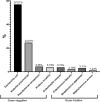Frequency of drug-resistant bacterial isolates among pregnant women with UTI in maternity and children's hospital, Bisha, Saudi Arabia
- PMID: 38548851
- PMCID: PMC10978862
- DOI: 10.1038/s41598-024-58275-5
Frequency of drug-resistant bacterial isolates among pregnant women with UTI in maternity and children's hospital, Bisha, Saudi Arabia
Abstract
Urinary tract infections (UTIs) are one of the most prevalent bacterial infections affecting humans, with a higher incidence among women. Pregnant women are at an increased risk of developing UTIs, which can have detrimental consequences for both the mother and fetus. UTIs can be caused by various bacteria, and the prevalence of drug-resistant UTIs in maternity and children's hospitals is a cause for concern due to the potential for severe complications if left untreated. The primary objective of the current study was to determine the distribution of UTI-causing bacteria and investigate the antibiotic sensitivity patterns of isolated cultures obtained from pregnant women with UTIs at the Maternity and Children's Hospital, Bisha, Saudi Arabia. This cross-sectional study was conducted from October 2021 to October 2023, involving the analysis of urine samples collected from 321 participants who acquired UTIs during pregnancy. Using biochemical tests and standard cultures, the urine samples were examined for pathogenic bacteria and their anti-microbial sensitivity patterns. The study analyzed susceptibility results according to the Clinical Laboratory Standards Institute guidelines (M100, 28th Edition, 2018). Bacterial strains demonstrating resistance to three or more antibiotics were classified as multidrug-resistant (MDR). This study revealed the distribution of UTI-causing bacteria to be as follows: Escherichia coli, 57.01%; Klebsiella pneumoniae, 24.61%; Pseudomonas aeruginosa, 4.36%; Proteus mirabilis and Enterobacter cloacae, 3.74%; Streptococcus agalactiae, 3.11%; Enterococcus faecalis, 2.18%; and Staphylococcus aureus, 1.24%. Antimicrobial susceptibility testing varied among gram-positive and gram-negative bacteria. Gentamicin demonstrated the highest sensitivity among both gram-positive and gram-negative bacteria; piperacillin-tazobactam was the second most effective drug against gram-negative bacteria. The bacterial isolates showed varying susceptibility to different antibiotics, with Escherichia coli, Klebsiella pneumoniae, and Pseudomonas aeruginosa being mainly sensitive to gentamicin, piperacillin-tazobactam, and ciprofloxacin, respectively. The strategies for reducing the risk of UTIs need to be improved to limit the spread of MDR bacteria. These strategies may include promoting hygienic practices and administering appropriate antibiotics to prevent the emergence and spread of drug-resistant bacteria. Further research is required to monitor the trends in antibiotic resistance among UTI-causing bacteria and develop effective strategies for managing this public health menace.
Keywords: Antimicrobial susceptibility; Complications; Prevalence; Pyelonephritis; Urinary tract infections.
© 2024. The Author(s).
Conflict of interest statement
The authors declare no competing interests.
Figures
Similar articles
-
Prevalence and Resistance Patterns of Urinary Tract Infection in Al-Madinah Al-Munawarah, Saudi Arabia: A Retrospective Study.Discov Med. 2024 Apr;36(183):853-864. doi: 10.24976/Discov.Med.202436183.80. Discov Med. 2024. PMID: 38665033
-
Epidemiology and Antimicrobial Resistance Patterns of Urinary Tract Infections: A Cross-Sectional Study from Southwestern Saudi Arabia.Medicina (Kaunas). 2023 Aug 2;59(8):1411. doi: 10.3390/medicina59081411. Medicina (Kaunas). 2023. PMID: 37629701 Free PMC article.
-
Prevalence and bacteriology of culture-positive urinary tract infection among pregnant women with suspected urinary tract infection at Mbarara regional referral hospital, South-Western Uganda.BMC Pregnancy Childbirth. 2021 Feb 23;21(1):159. doi: 10.1186/s12884-021-03641-8. BMC Pregnancy Childbirth. 2021. PMID: 33622283 Free PMC article.
-
Sulopenem: An Intravenous and Oral Penem for the Treatment of Urinary Tract Infections Due to Multidrug-Resistant Bacteria.Drugs. 2022 Apr;82(5):533-557. doi: 10.1007/s40265-022-01688-1. Epub 2022 Mar 16. Drugs. 2022. PMID: 35294769 Review.
-
An update on the management of urinary tract infections in the era of antimicrobial resistance.Postgrad Med. 2017 Mar;129(2):242-258. doi: 10.1080/00325481.2017.1246055. Epub 2016 Oct 21. Postgrad Med. 2017. PMID: 27712137 Review.
Cited by
-
Infection Leading to Breast Abscess Formation in Pregnancy: A Case Report.Int Med Case Rep J. 2025 Jul 4;18:791-809. doi: 10.2147/IMCRJ.S512859. eCollection 2025. Int Med Case Rep J. 2025. PMID: 40636480 Free PMC article.
-
Chromium yeast promotes milk protein synthesis by regulating ruminal microbiota and amino acid metabolites in heat-stressed dairy cows.Anim Nutr. 2024 Nov 28;20:120-130. doi: 10.1016/j.aninu.2024.11.003. eCollection 2025 Mar. Anim Nutr. 2024. PMID: 39967697 Free PMC article.
References
-
- Harding M. Urinary Tract Infection in Adults. Patient Platform Limited; 2017.
-
- MedlinePlus . Kidney Failure. What is Renal Failure? Johns Hopkins Medicine; 2017.
-
- Clatworthy M. Nephrology: Clinical Cases Uncovered. Wiley; 2010. p. 28.
-
- Ferri FF. Ferri’s Clinical Advisor 2018 E-Book: 5 Books in 1. Elsevier; 2017. p. 37.
MeSH terms
Substances
LinkOut - more resources
Full Text Sources
Medical
Molecular Biology Databases


